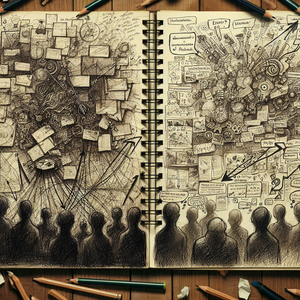The Philosophy of the Rear End: How Bumper Stickers Reflect Society and Identity

At their core, bumper stickers are a microcosm of the society that produces them. They capture a snapshot of the cultural zeitgeist, carrying the weight of collective beliefs, anxieties, and humor within their adhesive boundaries. For instance, consider the divisive yet humor-tinged “My Other Car Is a Tesla.” On the surface, it’s amusing, but beneath the humor lies a commentary on consumerism, environmental aspirations, and socioeconomic status. Similarly, the widely recognized “Coexist” bumper sticker, with its blend of religious and cultural symbols, encapsulates a modern call for tolerance and unity. It’s a peaceful plea, yet it also underscores the societal divisions that necessitate such a message. Beyond mainstream values, bumper stickers are a platform for niche communities and subcultures as well. A sticker like “Keep Portland Weird” expresses regional pride and a countercultural ethos, while “Proud Parent of a Dungeon Master” humorously celebrates the often-overlooked world of tabletop gaming. These stickers give voice to the quirky, the marginalized, and the unapologetically unique, allowing individuals to claim their place in a larger cultural narrative. Whether political, social, or comedic, bumper stickers function as a mirror to the diversity of human experience.
The Desire for Identity in Traffic
Why do people feel compelled to slap their beliefs, jokes, or philosophies onto their cars? Sociologists might argue that it stems from a deep-seated desire for identity and connection. In the isolating context of modern life – particularly while sitting in the bubble of a car, surrounded by strangers in their own bubbles – bumper stickers act as a bridge between individuals. They declare, “I am here, and this is what I stand for.” Take, for example, the ubiquitous “Baby On Board” sticker. On the surface, it’s a plea for cautious driving, but it’s also a proud proclamation of parenthood. Similarly, a sticker that reads “Not All Who Wander Are Lost” signals a free-spirited, adventurous identity – even if the driver is simply commuting to a 9-to-5 job. These stickers allow drivers to reclaim their individuality in a sea of mostly indistinguishable vehicles. However, the desire for identity can sometimes lead to friction. Political bumper stickers are particularly polarizing. A “Make America Great Again” sticker might elicit a thumbs-up from one driver and an exasperated sigh from another. In this way, bumper stickers are not just personal declarations – they’re a form of public performance, inviting both approval and critique. They remind us that identity is not just about self-expression; it’s also about how others perceive and react to that expression.
The Art of Condensing Complexity
One of the most fascinating aspects of bumper stickers is their brevity. In a world oversaturated with information, they aim to distill an entire worldview, joke, or call to action into just a few words or images. This requires a mastery of wit and simplicity that rivals even the best advertising slogans. Take the classic “Visualize World Peace.” In just three words, it encapsulates an idealistic vision of global harmony. The comedic variation, “Visualize Whirled Peas,” subverts this earnestness, offering a playful, absurd twist. Another example is the iconic “Honk If You Love Jesus,” which combines faith with an interactive element, inviting responses from fellow drivers – whether they’re enthusiastic or irritated. However, not all bumper stickers succeed in their quest for brevity and impact. Some fall into the trap of being verbose or cryptic, leaving drivers squinting to decipher the message. Others rely on clichés or offensive humor, alienating more people than they engage. The best bumper stickers strike a balance: they’re clever, concise, and universally comprehensible.
The Dark Side of Adhesive Expression
Not all bumper stickers are lighthearted or harmless. Some delve into aggression, using the anonymity of the road to broadcast hostility or vitriol. Stickers like “If You Don’t Like My Driving, Get Off the Sidewalk” or “Gas, Grass, or Ass – Nobody Rides For Free” reflect a combative, in-your-face approach to self-expression. These stickers reveal the darker aspects of human nature – our anger, divisiveness, and willingness to provoke without consequence. On the other hand, some drivers use bumper stickers to promote positivity and kindness, counteracting the toxic road rage culture. Stickers like “Practice Random Acts of Kindness” or “You Are Loved” serve as small but powerful reminders of humanity’s better nature. While they may seem overly sentimental to some, they provide a much-needed dose of optimism in the midst of chaotic traffic.
Bumper stickers may seem trivial, but their impact on culture and communication is undeniable. They are an art form in their own right, blending humor, philosophy, and design into a uniquely portable medium. They may not solve the world’s problems, but they do offer moments of reflection, laughter, or connection in the most unlikely of places: the back of a car.
Pop Culture Analyst
BuzzFeed, Vice Media, NPR, or cultural research firms
Core Responsibilities
Research, analyze, and interpret cultural trends, memes, and social phenomena.
Write reports or articles on how cultural artifacts (e.g., bumper stickers, viral videos) shape societal identities.
Collaborate with media outlets, brands, or think tanks to provide cultural insights.
Key Skills
Expertise in sociology, anthropology, or cultural studies.
Strong writing and analytical skills with a focus on modern media.
Familiarity with niche subcultures and their impact on the mainstream.
Graphic Designer – Communication Stickers & Decals
Sticker Mule, Redbubble, Etsy-based small businesses, or marketing agencies
Core Responsibilities
Design visually impactful stickers, decals, or small-format graphics with clear, clever messaging.
Work closely with clients to develop custom designs that align with their identity or brand.
Stay current on design trends and cultural motifs to create relevant products.
Key Skills
Proficiency in Adobe Creative Suite or similar design tools.
Strong understanding of typography and color theory.
Ability to translate complex ideas into simple, visually engaging messages.
Social Media and Meme Strategist
Social media agencies, content marketing firms, or brands like Wendy’s, Netflix, and Pop-Tarts
Core Responsibilities
Craft witty, shareable content that resonates with diverse audiences, drawing from cultural touchpoints like bumper sticker humor.
Monitor trends and cultural shifts to keep content relevant and engaging.
Use analytics to determine the success of campaigns and adapt strategies accordingly.
Key Skills
A sharp sense of humor and cultural awareness.
Experience managing social media platforms (e.g., Instagram, TikTok, X).
Ability to distill complex ideas into concise, impactful messages.
Copywriter – Micro Content Specialist
Creative agencies like Ogilvy, small-scale print shops, or e-commerce platforms like Zazzle
Core Responsibilities
Write punchy, memorable taglines, slogans, and short-form content for marketing campaigns or products like bumper stickers and T-shirts.
Collaborate with branding teams to ensure messaging aligns with the target audience’s values and humor.
Research trends to keep content fresh and relevant.
Key Skills
Exceptional creativity and brevity in writing.
Understanding of cultural humor and emotional resonance.
Experience in advertising, branding, or e-commerce.
Urban Sociologist or Cultural Researcher
Universities, nonprofit organizations, urban research institutes, or government planning departments
Core Responsibilities
Study how urban artifacts (like bumper stickers, street art, or graffiti) reflect societal values and identities.
Conduct fieldwork, surveys, and interviews to collect data on cultural expressions in urban settings.
Publish findings in academic journals or collaborate with city planners to inform public art projects.
Key Skills
Advanced knowledge of sociology, anthropology, or cultural geography.
Strong research and data analysis capabilities.
Ability to connect micro-level cultural expressions to macro-level societal trends.


